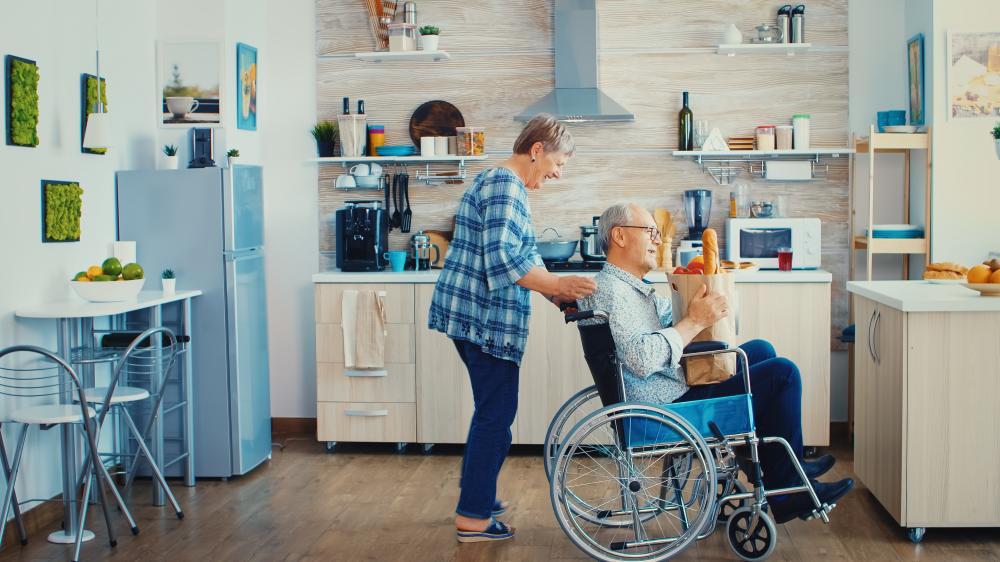Switching to a wheelchair is a big change for many senior people. Sometimes it happens after an injury; other times, it’s a gradual thing as bodies age. Either way, it’s a whole shift, both physically and emotionally. Helping a loved one through this stage takes patience and some empathy. Here’s how families and caregivers can help make the shift smoother and help their loved one feel at home in their new mobility reality.
The Wheelchair as a Reliable Companion
The right wheelchair makes a world of difference when it comes to comfort and simply enjoying daily life. There’s no one-size-fits-all option – each mobility aid type comes with its own set of features, depending on a person’s needs and lifestyle.
There are two basic types: manual and powered. Manual wheelchairs need some upper body strength (or a caregiver to help push), and they’re usually lighter and easier to pack up for trips. Power wheelchairs for adults run on batteries and are a better fit for people who don’t have the strength or can’t spend much energy getting around. When you’re picking out a mobility chair, pay close attention to what will actually work day-to-day for your loved one.
| Consideration | Why It Matters |
| Body Measurements | Ensures the seat fits properly and prevents pressure sores |
| Weight Capacity | Prevents strain on the frame and improves durability |
| Indoor vs. Outdoor Use | Impacts tire type, maneuverability, and battery life |
| Storage and Transport | Important for travel and home storage |
| Postural Support Needs | Essential for users with back or core strength issues |
Upgrade the Home Environment
Once someone starts using a wheelchair, it’s important to make a few changes around the house so things stay safe and easy to get around. Even small tweaks can really boost comfort and independence.
Begin with entryways and the spots your senior adult uses most. Doorways should be at least 32” wide so a wheelchair can fit through without a squeeze. You might need to add ramps or small bridges over thresholds if there are any steps. Inside, clear out anything you might trip over (like throw rugs) and set up some grab bars in the bathroom. Another good idea: move everyday items where they’re easy to reach – no need to stand up or stretch.
-
- Add ramps to every entry point
- Lower counters and light switches
- Put in slip-resistant floors
- Keep pathways open and easy to navigate
- Swap out standard doorknobs for lever handles
These updates let elderly people keep more control over their own space.
Promote Independence and Daily Function
It’s important to let seniors do things for themselves instead of always stepping in. Having a sense of independence really boosts confidence and mental health. Let your loved one take their time with everyday tasks-even if it means things move a little slower.
Adaptive tools can make a big difference: things like reachers, transfer boards, lap trays, or hands-free phone holders help seniors handle daily routines on their own, without needing a caregiver hovering nearby. Working with an occupational therapist can help too – they’ll walk you through ways to manage self-care, cooking, or household chores from a seated position.
Caregivers have to find the right balance: offer support when it’s needed, but encourage your loved one to do as much as they can by themselves. This helps them keep their dignity and builds resilience for the long run. Seniors who embraced independent living with supportive services tend to maintain a greater sense of confidence and self-worth. They also enjoy a higher quality of life, knowing that assistance is available without sacrificing their independence.
Maintain Physical Health
Just because your senior uses a wheelchair doesn’t mean they have to put their health on hold. If anything, keeping active becomes even more important. When you don’t move enough, problems like pressure sores, weak muscles, poor circulation, and stiff joints may sneak up faster than you’d think.
That’s where a tailored physical therapy plan can really make a difference. It might include things like upper body strength training (great for getting around more easily), stretching to keep you flexible and upright, and seated cardio workouts to take care of the heart. Plus, learning to shift their weight and lean in different directions helps take the pressure off certain spots.
Staying on the move – however your loved one can – and eating well aren’t just good for your body. They help keep a person sharp and energized, day in and day out.
Social Engagement and Mental Health
Feeling isolated is pretty common after moving to a wheelchair. Sometimes, seniors get embarrassed going out in public or get discouraged by all the accessibility hassles. That kind of frustration can cause them to shy away from social activities.
You can help keep them connected by making it easier to join in – whether it’s family get-togethers, local community events, or hobby groups (the more wheelchair-friendly, the better). It also helps to encourage hobbies that aren’t tied to getting around, like reading or gardening.
If they’re still struggling emotionally, don’t brush it off. Professional mental health support can make a real difference. Major life changes sometimes bring depression with them, and getting help early matters. Whether it’s therapy or peer groups, that extra support can really help them feel understood and less alone.
Educating Family and Caregivers
Caregivers really need to be ready – not just informed – to support seniors with both respect and safety in mind. Having the right training matters. Knowing how to handle wheelchair transfers, use good body mechanics, and keep the chair in a top-notch shape can make a difference when it comes to preventing injuries for everyone involved.
But it’s not just about the practical stuff. The attitude at home counts, too. Don’t treat the wheelchair as a sign of frailty. Think of it as what it really is: a tool that gives freedom and independence. Normalize using it around the house, and stand up for accessibility when you’re out and about.
-
- Keep conversations open – good communication helps everyone.
- Make sure you know how to help with transfers and mobility.
- Take time for your own self-care. Caregiver burnout is real, so don’t ignore it.
- Support seniors in setting small goals, and celebrate when they hit them – it means a lot.
Plan for Long-Term Mobility
Wheelchair needs don’t stay the same forever. As a senior gets older or their health shifts, it’s important to take another look at what kind of equipment works best. Checking in with healthcare pros and equipment experts now and then helps keep things comfortable and safe.
Planning ahead matters, too. Down the road, that might mean moving up to a more advanced wheelchair or maybe switching to a mobility scooter for getting around outside. Laying out a plan with professionals makes those changes easier when the time comes.
Conclusion
When an older adult starts using a wheelchair, things can feel heavy for everyone involved. At first, it’s a mess of questions, frustration, sometimes even grief over what’s changed. But if you’ve got backup – people who can actually help – and some decent mobility device, that sense of control starts to come back. Families and caregivers don’t just handhold. They push, pull, and scramble with their loved one through every weird, uncomfortable step of the adjustment. It’s not about picture-perfect support, but about figuring it out together and making sure a person gets to hang onto what makes them, well, them.
Want to learn more tips and tricks for feeling in control of your own life?
Snag a free workbook and get inspiration on all the ways to love your life even more.
>>Click Here to Discover Additional Articles on Strategies to Get Your Life on Track <<









